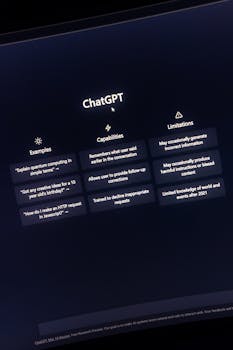The Role of ChatGPT in Therapy
Therapists often see ChatGPT as a handy tool. It can generate prompts that guide emotional exploration. But does it truly understand human feelings? I think it doesn’t.
Many believe AI can replace some therapeutic tasks. But I argue that the human touch is irreplaceable. Therapists build trust and rapport, which AI simply can’t replicate.
Some say ChatGPT can enhance therapy sessions. I agree, but only if used wisely. It can help brainstorm ideas or simulate conversations.
However, I worry about ethical implications. Confidentiality is a big deal. Using AI in therapy raises questions about data privacy.
In my view, therapists should use AI as a supplement, not a replacement. Traditional methods, like peer collaboration, often yield deeper insights. Workshops can foster authenticity that AI struggles to achieve.
Moreover, integrating AI responsibly is key. Training therapists on ethical AI use is essential. They must navigate the balance between technology and human connection.
As noted by David Meer from Neurodiverse Counseling Services, “Prompt engineering can be a game-changer for therapists looking to enhance their practice through AI.” This highlights the potential benefits of AI when used appropriately.
But let’s not forget: AI can’t feel. It can’t empathize. It’s just a tool, and we need to use it wisely.
Do you not Want to put more things into it and get more feedback back. You be showing the grit and determination of a season seafarer. Set and sail the seas of …
Future Trends: Integrating AI and Human Insights in Therapy
Many believe AI can’t replace human therapists. I disagree. The future of therapy lies in blending AI with human insights. Imagine a scenario where AI manages administrative tasks while therapists focus on emotional connections. It’s a win-win!
AI can analyze patterns in client behavior, offering valuable insights. But therapists bring empathy and understanding that AI lacks. This mix can enhance therapy sessions significantly.
Some argue that AI tools might dilute the therapeutic relationship. I think the right integration can strengthen it. By using AI as a supplement, therapists can allocate more time to what truly matters—building trust and rapport.
Moreover, AI can help therapists develop tailored interventions based on data. This means more personalized care for clients. As David Meer from Neurodiverse Counseling Services said, “Prompt engineering can be a game-changer for therapists looking to enhance their practice through AI.” See more insights here.
While AI offers tools for emotional exploration, the human touch remains irreplaceable. We need to focus on training therapists in AI ethics and integration. This ensures that technology enhances rather than compromises the therapeutic process.
In conclusion, the future is bright. By combining AI’s efficiency with the warmth of human insight, we can create a more effective therapeutic environment.
Limitations and Ethical Considerations of AI in Therapy
Many therapists see AI as a helpful tool. But I disagree because AI lacks genuine emotional understanding. It can’t truly grasp the complexities of human feelings.
Take confidentiality, for instance. Most people think AI can securely handle sensitive data. I think that’s risky because data breaches can happen, putting client trust at stake.
AI-generated insights can be misleading. Some argue that AI can analyze patterns effectively. I believe its inability to interpret nuanced emotions can lead to incorrect conclusions.
Ethics are a major concern, too. While some advocate for AI’s efficiency, I think it raises questions about client autonomy. Clients deserve a therapist who understands their unique experiences.
Human therapists build trust and rapport. Most believe AI can replicate this. I think it’s impossible because the human connection is irreplaceable.
As Oliver from My People Patterns said, “When using AI for therapy notes, avoid assuming the AI understands the client’s emotional landscape comprehensively.” This highlights a critical limitation.
It’s not just about technology; it’s about human care. Therapists should prioritize emotional intelligence over AI’s convenience. Balancing these aspects is key to effective therapy.
We must train therapists to use AI responsibly. This means understanding its limitations while enhancing their practice. The future of therapy should focus on combining AI benefits with human insight.
Alternative Approaches to Traditional Therapy Methods
Most therapists lean heavily on traditional methods. They believe the human touch is irreplaceable. But I think integrating AI can actually enhance therapy.
AI tools like ChatGPT can generate prompts that spark deeper conversations. Imagine a therapist using AI to create tailored scenarios. This can lead to richer emotional exploration.
Many argue that AI lacks empathy. Sure, it’s not a human, but it can provide unique insights. For instance, AI can analyze patterns in a client’s speech and suggest areas to explore further.
Some therapists might worry about losing the personal connection. But I believe that using AI doesn’t have to replace that connection. It can complement it by providing additional layers of understanding.
While traditional methods involve one-on-one sessions, AI can offer 24/7 support. Clients can access prompts anytime, helping them reflect outside of therapy hours.
According to David Meer from Neurodiverse Counseling Services, “Prompt engineering can be a game-changer for therapists looking to enhance their practice through AI.” This shows that AI can be a powerful ally.
Now, let’s talk about the ethical side. Some believe using AI in therapy could compromise confidentiality. But with proper guidelines, AI can be used responsibly. The key is training therapists to integrate these tools effectively.
In my view, the future of therapy should embrace both AI and human insights. This combination can create a more holistic approach, making therapy more accessible and effective.
Feb 21, 2024 …ChatGPT prompts into your occupational therapy practice to meet professional requirements while enhancing treatment planning, intervention strategies, and …
May 25, 2023 … My therapist would say I… ME: Help me fill out my Hinge dating profile. Answer this prompt for me in 150 characters or less: My therapist …
Key Features of Effective ChatGPT Prompts
Here are some essential features that make ChatGPT prompts effective for therapists.
Dec 13, 2022 … Decide on a name for yourself and stick with it. Begin by welcoming me to your office and asking me for my name. Wait for my response. Then ask …
[FIX:ChatGPT] Therapist prompt for ChatGPT : r/prompthacking
Apr 17, 2024 …ChatGPT Therapist Prompts · Prompt #1: Expert-Level, Human-Sounding Psychotherapist · Prompt #2: Extremely Nice, Warm, and Friendly Therapist.
Best ChatGPT Therapist Prompts – AI is Here to Dry Your Tears …
Apr 9, 2024 … … prompts to use to have ChatGPT to work like a therapist? It would be … Therapy, Wilderness Therapy, Somatic Therapy, Teletherapy, and Online …
47.3K3d ago. melissagraymua. Melissa. Chatgpt now becoming my online therapist never thought creating a map to my dream life could be so easy ???? You HAVE …
Benefits of Using AI Prompts for Therapists
Using AI prompts in therapy can be a total game changer. They offer quick insights and fresh perspectives. Imagine having a tool that sparks creativity in sessions. It’s like having an extra brain to bounce ideas off.
Many therapists find that AI can help structure conversations. This can lead to deeper discussions about emotions and experiences. For instance, prompts can help clients articulate feelings they might struggle to express. It’s that simple!
According to David Meer from Neurodiverse Counseling Services, “Prompt engineering can be a game-changer for therapists looking to enhance their practice through AI.” Check out his insights here. This shows that AI can indeed complement traditional methods.
Some might think AI lacks the human touch. But I believe it can actually enhance the therapeutic experience. It’s a tool, not a replacement. AI can help therapists focus more on the emotional connection with clients.
However, let’s not forget the importance of human insights. AI should be seen as a supplement, not a substitute. Traditional methods, like peer coaching, can provide emotional depth that AI often misses. Engaging with real human experiences is irreplaceable.
There’s a fascinating new topic emerging: the need for therapists to integrate AI responsibly. Training therapists on how to use AI ethically is crucial. This ensures that client care remains the top priority while utilizing innovative tools.
What are the advantages of using ChatGPT in therapy?
Many people think that AI in therapy is just a gimmick. But I believe it can significantly enhance therapeutic practices. ChatGPT can provide therapists with effective prompts that stimulate deeper conversations.
Imagine having a tool that helps you explore emotions in real-time! AI can generate scenarios that allow clients to rehearse difficult conversations. This can be invaluable for those who struggle with emotional expression.
Some argue that AI lacks empathy. Sure, it can’t replace the human touch, but it offers unique insights that traditional methods sometimes miss. For instance, using AI can help therapists identify patterns in client behavior.
While some may feel that relying on AI diminishes the therapeutic experience, I see it as a complementary tool. It can boost creativity and inspire fresh approaches in therapy. Plus, it keeps sessions engaging and dynamic.
As noted by David Meer from Neurodiverse Counseling Services, “Prompt engineering can be a game-changer for therapists looking to enhance their practice through AI.” This shows that integrating AI can lead to a more enriched therapeutic environment.
In contrast, traditional methods often lack the adaptability that AI can provide. Workshops or peer coaching might yield deeper emotional insights, but they can be time-consuming. AI offers efficiency without sacrificing quality.
How can therapists create effective prompts for ChatGPT?
Creating effective prompts for ChatGPT is all about clarity and intention. Most therapists think that just asking a question is enough. I think that specific, targeted prompts yield better results because they guide the AI to generate relevant responses.
For instance, instead of saying, ‘What should I do?’, try, ‘What strategies can I use to help a client struggling with anxiety?’ This approach narrows the focus and elicits more useful insights.
It’s also crucial to incorporate emotional context. A prompt like, ‘How can I support a client feeling overwhelmed?’ adds depth. This helps ChatGPT understand the emotional landscape, leading to more tailored suggestions.
According to David Meer from Neurodiverse Counseling Services, “Prompt engineering can be a game-changer for therapists looking to enhance their practice through AI.” This highlights the need for therapists to refine their prompts continually.
Some people believe AI can replace the human touch in therapy. I think that’s a misunderstanding because AI lacks genuine empathy. Combining AI tools with human insights creates a richer therapeutic experience.
Incorporating feedback from AI responses can also refine future prompts. This iterative process allows therapists to adapt and improve their interactions with ChatGPT.
Lastly, therapists should explore the ethical implications of using AI. Integrating AI responsibly ensures that it complements rather than compromises the therapeutic relationship.
What ethical issues arise with AI in therapy?
Many believe AI can streamline therapy. But I think it raises serious ethical concerns. Confidentiality is a big deal. AI might mishandle sensitive data.
Most therapists trust their instincts. AI lacks the emotional nuance that human therapists bring. It’s that simple. AI can’t truly understand human feelings.
Some argue AI can enhance therapy. But I see it as a potential risk. If clients rely too much on AI, they might miss out on genuine connections.
According to Oliver @ My People Patterns, “When using AI for therapy notes, avoid assuming the AI understands the client’s emotional landscape comprehensively.” That says it all.
We need to think about how we use AI. Balancing technology with human insight is key. The future of therapy should focus on preserving that human touch.
Can AI replace human therapists?
No way! Most people think AI can step in for therapists. But I believe that human therapists are irreplaceable because they provide genuine emotional support and connection.
AI lacks the ability to grasp complex human emotions. It can generate prompts, but it can’t feel empathy. According to Oliver from My People Patterns, “When using AI for therapy notes, avoid assuming the AI understands the client’s emotional landscape comprehensively.” That says it all!
While AI tools can be useful, they can’t replicate the warmth and understanding of a human therapist. Engaging in person-to-person sessions creates trust and a deeper connection, which is essential for healing.
Plus, let’s talk about ethics. Relying on AI might compromise the therapeutic relationship. Therapists need to navigate these waters carefully.
I think the future lies in collaboration. AI can assist, but it shouldn’t replace the human touch. The best outcomes will come from integrating AI tools into therapy while keeping the human element front and center.
How can therapists balance AI tools with personal touch?
Many believe that AI tools like ChatGPT can replace the human touch in therapy. I think that’s a mistake. AI is a tool, not a substitute for genuine human connection.
Using AI can streamline certain tasks, like generating prompts. But therapy needs empathy, understanding, and warmth—qualities AI simply can’t replicate.
Some argue that AI can enhance therapeutic practices. However, I believe relying too much on AI could lead to a sterile experience that misses the emotional nuances.
It’s about finding a balance. Combine AI’s efficiency with the personal touch that only a human therapist can provide. That’s where real healing happens.
As noted by David Meer from Neurodiverse Counseling Services, “Prompt engineering can be a game-changer for therapists looking to enhance their practice through AI.” But let’s not forget the heart of therapy lies in human connection.
Many therapists use AI for administrative tasks or brainstorming. But the therapeutic alliance is built on trust and empathy. AI can’t offer that.
Incorporating AI responsibly means understanding its limitations. Ethical concerns about confidentiality and emotional understanding are paramount. I believe therapists should be trained to use AI without compromising the quality of care.
So, let’s embrace AI as a tool, not a replacement. The future of therapy should blend technology with the irreplaceable human element.
What are the limitations of using ChatGPT in therapy?
Many people think ChatGPT can replace human therapists. I strongly disagree because AI lacks true emotional understanding. It can generate responses but misses the nuances of human emotions.
For instance, AI might suggest coping strategies, but it can’t feel the weight of a client’s pain. As Oliver from My People Patterns points out, “When using AI for therapy notes, avoid assuming the AI understands the client’s emotional landscape comprehensively.”
Another limitation is confidentiality. AI tools require data, which raises concerns about privacy. Clients need to trust their therapists, and AI can complicate that.
Most discussions focus on AI’s efficiency, but I believe the human touch is irreplaceable. Traditional therapy fosters real connections, something AI simply can’t replicate.
Moreover, ethical concerns are huge. How do we ensure AI is used responsibly in therapy? This is a question we need to tackle head-on.
In conclusion, while AI can support therapy, it should never replace the human element. The future of therapy lies in responsibly integrating AI while maintaining genuine human connections.
How is the future of therapy changing with AI integration?
Many therapists believe AI can enhance therapy. I think it can, but only if we use it wisely. AI tools like ChatGPT can help therapists create prompts that evoke deeper emotional exploration.
Most people think AI will replace human therapists. I disagree because the human touch is irreplaceable. AI can assist but cannot replicate the empathy and understanding that comes from a real therapist.
Ethical concerns are often brushed aside. But I believe they’re crucial. We must ensure that client data remains confidential and that AI interventions are appropriate.
Some suggest traditional therapy methods are outdated. However, I think they still hold immense value. Peer coaching and collaboration can lead to authentic emotional insights that AI struggles to capture.
Future trends should focus on training therapists to integrate AI responsibly. This way, they can leverage AI’s efficiency while maintaining the quality of client care. As noted by David Meer from Neurodiverse Counseling Services, “Prompt engineering can be a game-changer for therapists looking to enhance their practice through AI.”
AI prompts can transform therapy sessions. They offer fresh perspectives and stimulate conversations. I believe they can help clients articulate emotions better.
Most therapists think traditional methods are the only way. But I think integrating AI tools can enhance therapeutic practices. They can help clients explore feelings in a new light.
According to David Meer from Neurodiverse Counseling Services, “Prompt engineering can be a game-changer for therapists looking to enhance their practice through AI.” This shows the potential of AI in therapy.
However, human therapists remain irreplaceable. They provide the warmth and understanding that AI lacks. Balancing AI tools with personal touch is key.
Ethical concerns are real. Client data privacy must be prioritized. Using AI responsibly ensures a better therapeutic experience.
Let’s not forget, AI can’t replace the human connection. It’s a tool, not a therapist. The future is about collaboration between AI and human insights.
Most people think AI tools can fully replace human therapists. I think that’s a mistake because AI lacks genuine empathy and emotional understanding. Sure, AI can provide prompts, but it can’t feel.
Human therapists build trust through personal connections. They offer warmth and insight that AI simply can’t replicate. As David Meer from Neurodiverse Counseling Services said, “Prompt engineering can be a game-changer for therapists looking to enhance their practice through AI.” But, it’s about using AI wisely.
Integrating AI should enhance therapy, not replace it. Balancing AI’s efficiency with human touch creates a richer experience. Let’s not forget, the heart of therapy is human connection.
Most people think AI tools like ChatGPT are the best for therapy. I disagree because peer coaching can bring genuine emotional depth. It’s all about real connections, right?
AI lacks the warmth and understanding that comes from human interaction. Peer coaching allows for shared experiences, which can lead to profound insights. According to David Meer, “AI can support emotional exploration, but the human element remains crucial in therapy”.
Let’s face it, AI can’t replicate the nuances of human emotions. So, why not blend both approaches? Using AI for brainstorming while relying on peer support for authenticity could be the perfect combo!
Many believe AI can streamline therapy, but I think it raises serious ethical issues. Confidentiality is a big deal. We can’t just trust AI with sensitive client information.
AI lacks true emotional understanding. It can’t replace the human connection that clients need. Relying solely on AI might compromise the therapeutic relationship.
According to Oliver @ My People Patterns, “When using AI for therapy notes, avoid assuming the AI understands the client’s emotional landscape comprehensively.” This highlights the need for human oversight.
Instead of replacing therapists, AI should assist them. Balancing AI’s efficiency with the warmth of human interaction is key. We should embrace technology but remain vigilant about its limitations.
Most therapists think AI can’t replace human connection. I believe that blending AI with human insights can actually enhance therapy. Imagine using AI for data analysis while therapists focus on emotional nuances.
AI can streamline administrative tasks, giving therapists more time for personal interactions. This balance can lead to a richer therapeutic experience. As David Meer from Neurodiverse Counseling Services said, “Prompt engineering can be a game-changer for therapists.”
Many argue that AI lacks empathy. But I think it can complement human skills, making sessions more dynamic. The key is training therapists to use AI responsibly while prioritizing client care.
Exploring how AI can support emotional intelligence without overshadowing human connection is essential. This integration could redefine therapy, offering both efficiency and depth.

Albert Mora is an internationally renowned expert in SEO and online marketing, whose visionary leadership has been instrumental in positioning Aitobloggingas a leader in the industry.


